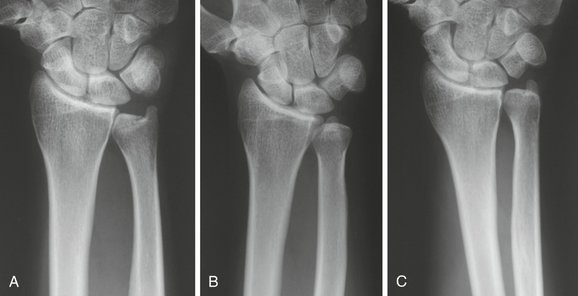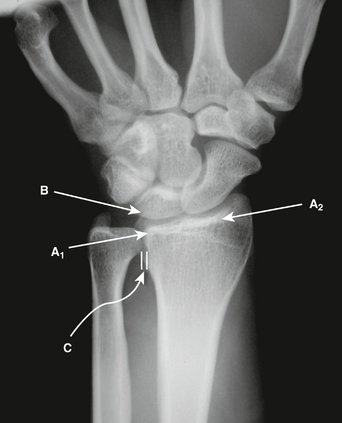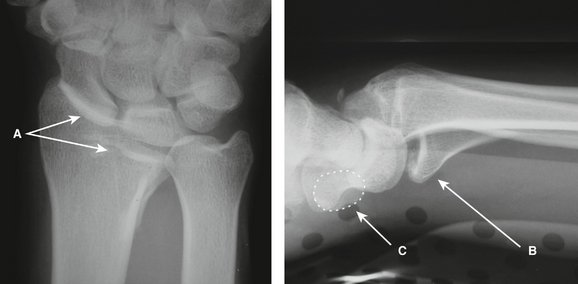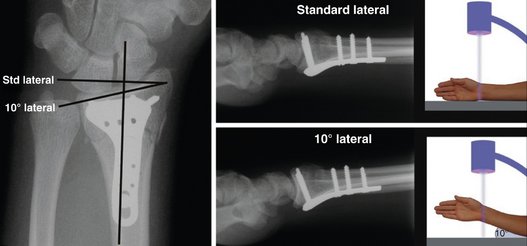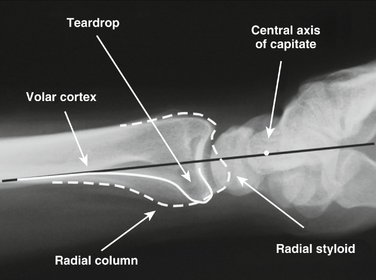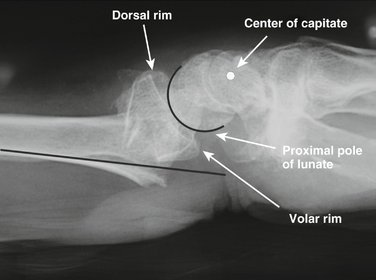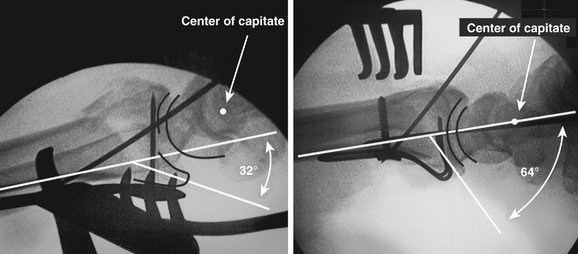CHAPTER 3 Radiographic Evaluation and Classification of Distal Radius Fractures
X-rays are essential to the treatment of distal radius fractures. When combined with the age and baseline level of activity of the patient, the interpretation of a patient’s x-rays significantly influences the type of treatment selected. Radiographs form the basis for nearly every system of classification of distal radius fractures. Radiographs also are used during procedures to judge residual fragment displacements and to determine whether hardware has been placed appropriately. Ultimately, x-rays are the means used to assess the quality of the final reduction and treatment.1 By improving the interpretation of standard x-rays, a better understanding of the pattern of injury emerges, which improves algorithms for treatment and ultimately results in better clinical outcomes.
Radiographic Landmarks
Posteroanterior View
The actual x-ray technique directly affects the quality and characteristics of the visual information that is presented on the radiographic image. It is not unusual to receive injury films that have been poorly positioned or were taken with poor radiographic technique from emergency staff members who were unwilling to move an injured arm for fear of causing additional pain or injury to the patient. X-rays of an unreduced, highly displaced fracture compound the difficulties of interpretation because of the distortion from abnormal displacement and rotation of fracture components. In some cases, determining the nature of a complex injury is no more complicated than simply obtaining a second set of films after a closed reduction with proper positioning and technique. Finally, articular visualization on the PA view may be improved by angling the x-ray beam 10 degrees proximally.2
The rotational position of the forearm also can change the appearance of the radiographic image (Fig. 3-1).3 On a standard PA view of the wrist with the forearm in neutral position, the cortical bone along the ulnar border of the ulnar styloid connects smoothly with the cortical bone along the ulnar border of the shaft. In addition, the cortical outline of the ulnar head does not extend behind the ulnar styloid, and the lateral border of the distal ulnar shaft has a concave outline on its radial side. Subtle changes occur if this view is taken with the forearm in full supination (typically done as an anteroposterior [AP] view). In this situation, the position of the ulnar styloid shifts radially to align more toward the central longitudinal axis of the ulnar shaft. In addition, the ulnar shaft shows a more linear appearance along its radial border, and the subchondral bone of the ulnar head can be seen superimposed over the ulnar styloid.
With the forearm in a position of full pronation, the radius crosses over the ulna resulting in an obligate but physiological shortening of the radius in relation to the ulna. In this position of forearm rotation, a normal loss of about 0.5 mm of radial length is common. In addition, the radial and ulnar shafts appear to converge proximally, and the cortical outline of the ulnar head can be identified behind the base of the ulnar styloid. With pronation of the forearm, measured values of radial inclination, volar tilt, and radial height decrease; with supination of the forearm, these values increase.4
The carpal facet horizon is a radiodense line that appears on a normal PA view near the distal articular surface and extends from the ulnar side of the radius across most of the width of the bone (Fig. 3-2). In a normal wrist, the carpal facet horizon is inclined at an angle of about 10 degrees to a perpendicular of a line extended from the longitudinal axis of the radius. The carpal facet horizon is a radiographic landmark that is produced by the x-ray beam as it crosses a portion of the curved arc of dense subchondral bone that is tangential to the axis of the beam. Because a normal distal radius has a volar tilt of 5 to 8 degrees, under normal circumstances, the volar portion of the subchondral plate is the part of the articular surface that is parallel to the x-ray beam. As a result, in a PA view of a normal wrist, the carpal facet horizon identifies the volar rim of the lunate facet and extends ulnar to the volar corner of the sigmoid notch.
Identification of the carpal facet horizon has several clinical applications. Discontinuity of this landmark suggests the presence of a separate intra-articular fracture component. Isolated volar shear fractures with proximal and volar displacement of a free volar rim fragment can show an obvious step-off in the carpal facet horizon on the PA projection and imply the presence of an articular fragment (Fig. 3-3). The carpal facet horizon also is used to identify whether a particular fragment on the PA view involves the dorsal rim or volar rim. In fractures that are volarly displaced in which there is volar tilt of the articular surface on the lateral x-ray, the carpal facet horizon identifies the volar rim of the lunate facet. In fractures that are dorsally displaced in which there is dorsal tilt of the articular surface on the lateral x-ray, the carpal facet horizon identifies the dorsal rim of the lunate facet. Determining whether a particular articular fragment is located dorsally or volarly on the PA view can be crucial in assessing the pattern of instability and in considering surgical approaches (Fig. 3-4).

FIGURE 3-4 Clinical Application of the Carpal Facet Horizon. Top panel, In the dorsal injury, the distal fragment has rotated dorsally causing the dorsal portion of the subchondral bone to align with the axis of the x-ray beam. In this case, the carpal facet horizon (A1-A2) identifies the dorsal rim of the lunate facet. Note the position of the dorsal ulnar corner (A2) and the volar corner of the sigmoid notch (V). Discontinuity of the carpal facet horizon indicates an additional free articular fragment. Bottom panel, In the volar injury, the distal fragment has rotated volarly. As a result, the volar rim of the lunate facet is aligned with the x-ray beam, and the carpal facet horizon (B1-B2) identifies the volar rim. Note the position of the volar corner (B1) and dorsal corner (D) of the sigmoid notch. Also note the irregularity of the carpal facet horizon indicating a separate volar rim and radial column fragment.
Lateral View
The lateral x-ray is normally taken with the forearm in neutral rotation. The accuracy of obtaining a true lateral film can be checked by noting the position of the pisiform in relation to the distal pole of the scaphoid on the lateral view. On a true lateral x-ray, the pisiform is located directly over the distal pole of the scaphoid (see Fig. 3-3). If the pisiform lies dorsal to the distal pole of the scaphoid, the forearm is rotated into pronation, and the x-ray is more oblique. Although this type of oblique view can put the volar portion of the radial column in profile, it also results in suboptimal visualization of the volar rim.
In addition to a standard lateral view, the 10-degree lateral view provides a sharper image of the articular surface. The 10-degree lateral view is so named because the ulnar two thirds of the articular surface is normally at an inclination of about 10 degrees to a perpendicular of a line extended along the longitudinal axis of the radius. In some patients, this angle may be greater to correspond to variations in the tilt of the ulnar two thirds of the articular surface.5,6 The technique for taking the 10-degree lateral view is simple. The forearm is initially positioned horizontally on the plate as if to take a standard lateral x-ray and then elevated 10 degrees off the horizontal plane. If done properly, the articular outline of the ulnar two thirds of the radiocarpal joint is placed into sharp relief (Fig. 3-5). This view positions the outline of the radial styloid more proximally than is normally seen on the standard lateral view and may affect the appearance of hardware placed on or into the radial styloid.
The teardrop is a dense, U-shaped outline seen at the distal end of the radius on the lateral view; it is formed from the confluent outlines of the distal shaft and distal radial ridge, and terminates in the volar rim of the lunate facet (Fig. 3-6). The thickness of the cortical bone that forms the base of the teardrop is noted to be significantly greater than the thickness of the dorsal cortical bone and reflects the greater loading forces that normally occur along the volar surface of the radius. In addition, a line that extends from the volar cortex of the radial shaft nearly bisects the curve of the articular surface (typically passing just volar to the center of the articular surface on the lateral view), suggesting that the carpal load is nearly balanced along the volar cortex.
The distal articular surface of the radius on a normal wrist has an arc of curvature that matches the arc of curve of the proximal pole of the lunate; this uniform joint interval is more clearly seen on the 10-degree lateral x-ray. Fractures that result in a joint interval that is nonuniform from the dorsal to volar margin or show incongruent arcs of curvature between the articular surface of the distal radius and the proximal pole of the lunate imply discontinuity between the volar and dorsal joint surfaces with independent articular fracture components (Fig. 3-7).
Carpal alignment also is an important feature to observe on the lateral x-ray. With a wrist in neutral to slight dorsiflexion, a line extended from the volar cortex of the radial shaft should be nearly collinear with the center axis of rotation of the proximal pole of the capitate (see Fig. 3-6). Fractures with dorsal angulation or displacement cause translation of the carpus dorsally, resulting in dorsal migration of the proximal pole of the capitate relative to the volar cortex of the radial shaft (Fig. 3-8). Fractures that displace to the volar side result in volar migration of the capitate from its normal alignment with the radial shaft and are highly unstable. Significant displacement of the carpus in either direction changes the functional moment arm of tendons that cross the wrist and may contribute to adverse affects on grip strength.

